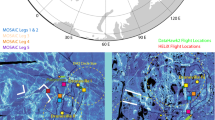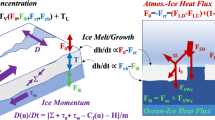Abstract
Atmospheric brown clouds are mostly the result of biomass burning and fossil fuel consumption1. They consist of a mixture of light-absorbing and light-scattering aerosols1 and therefore contribute to atmospheric solar heating and surface cooling. The sum of the two climate forcing terms—the net aerosol forcing effect—is thought to be negative and may have masked as much as half of the global warming attributed to the recent rapid rise in greenhouse gases2. There is, however, at least a fourfold uncertainty2 in the aerosol forcing effect. Atmospheric solar heating is a significant source of the uncertainty, because current estimates are largely derived from model studies. Here we use three lightweight unmanned aerial vehicles that were vertically stacked between 0.5 and 3 km over the polluted Indian Ocean. These unmanned aerial vehicles deployed miniaturized instruments measuring aerosol concentrations, soot amount and solar fluxes. During 18 flight missions the three unmanned aerial vehicles were flown with a horizontal separation of tens of metres or less and a temporal separation of less than ten seconds, which made it possible to measure the atmospheric solar heating rates directly. We found that atmospheric brown clouds enhanced lower atmospheric solar heating by about 50 per cent. Our general circulation model simulations, which take into account the recently observed widespread occurrence of vertically extended atmospheric brown clouds over the Indian Ocean and Asia3, suggest that atmospheric brown clouds contribute as much as the recent increase in anthropogenic greenhouse gases to regional lower atmospheric warming trends. We propose that the combined warming trend of 0.25 K per decade may be sufficient to account for the observed retreat of the Himalayan glaciers4,5,6.
This is a preview of subscription content, access via your institution
Access options
Subscribe to this journal
Receive 51 print issues and online access
$199.00 per year
only $3.90 per issue
Buy this article
- Purchase on Springer Link
- Instant access to full article PDF
Prices may be subject to local taxes which are calculated during checkout



Similar content being viewed by others
References
Ramanathan, V. et al. Indian Ocean experiment: An integrated analysis of the climate forcing and effects of the great Indo-Asian haze. J. Geophys. Res. 106 doi: 10.1029/2001JD900133 (2001)
Forster, P. et al. in Climate Change 2007: The Physical Science Basis (Contribution of Working Group I to the Fourth Assessment Report of the Intergovernmental Panel on Climate Change) 131–217 (World Meteorological Organization, Geneva, 2007)
Winker, D. M., Vaughan, M. A. & Hunt, W. H. The CALIPSO mission and initial results from CALIOP. In Lidar Remote Sensing for Environmental Monitoring VII; Proc. SPIE 6409, 1–8 (2006)
Barnett, T. P., Adam, J. C. & Lettenmaier, D. P. Potential impacts of a warming climate on water availability in snow-dominated regions. Nature 438, 303–309 (2005)
Thompson, L. G. et al. Tropical glacier and ice core evidence of climate changes on annual to millennial time scales. Clim. Change 59, 137–155 (2003)
Vuille, M., Bradley, R. S., Werner, M. & Keimig, F. 20th century climate change in the tropical Andes. Clim. Change 59, 75–99 (2003)
Haywood, J. et al. Radiative properties and direct radiative effect of Saharan dust measured by the C-130 aircraft during SHADE: 1. Solar spectrum. J. Geophys. Res. 108 doi: 10.1029/2002JD002687 (2003)
Holland, G. H. et al. The aerosonde robotic aircraft: A new paradigm for environmental observations. Bull. Am. Meteorol. Soc. 82, 889–901 (2001)
Ramana, M. V. & Ramanathan, V. Abrupt transition from natural to anthropogenic aerosol radiative forcing: Observations at the ABC-Maldives Climate Observatory. J. Geophys. Res. 111 doi: 10.1029/2006JD007063 (2006)
Andrea, M. O. & Gelencser, A. Black carbon or brown carbon? The nature of light absorbing carbonaceous aerosols. Atmos. Chem. Phys 6, 3131–3148 (2006)
Ramaswamy, V. et al. in Climate Change 2001: The Scientific Basis (Contribution of Working Group I to the Third Assessment Report of the Intergovernmental Panel on Climate Change) (Cambridge Univ. Press, Cambridge, UK, 2001)
Corrigan, C. E., Ramanathan, V. & Schauer, J. J. Impact of monsoon transitions on the physical and optical properties of aerosols. J. Geophys. Res. 111 doi: 10.1029/2005JD006370 (2006)
Ramanathan, V. et al. Atmospheric brown clouds: impacts on south Asian climate and hydrological cycle. Proc. Natl Acad. Sci. USA 102, 5326–5333 (2005)
Chung, C. E., Ramanathan, V., Kim, D. & Podgorny, I. A. Global anthropogenic aerosol direct forcing derived from satellite and ground-based observations. J. Geophys. Res. 110 doi: 10.1029/2005JD006356 (2005)
Kiehl, J. T. et al. The National Center for Atmospheric Research Community Climate Model: CCM3. J. Clim. 11, 1131–1149 (1998)
Novakov, T. et al. Large historical changes of fossil-fuel black carbon aerosols. Geophys. Res. Lett. 30 doi: 10.1029/2002GL016345 (2003)
Washington, W. M. et al. Parallel climate model (PCM) control and transient simulations. Clim. Dyn. 16, 755–774 (2000)
Liu, X. D. & Chen, B. D. Climatic warming in the Tibetan plateau during recent decades. Int. J. Climatol. 20, 1729–1742 (2000)
Kulkarni, A. V., Rathore, B. P., Mahajan, S. & Mathur, P. Alarming retreat of Parbati glacier, Beas basin, Himachal Pradesh. Curr. Sci. 88, 1844–1850 (2005)
Ramanathan, V., Roberts, G., Corrigan, C., Ramana, M. V. & Nguyen, H. Maldives AUAV Campaign (MAC): Observing Aerosol-Cloud-Radiation Interactions Simultaneously from Three Stacked Autonomous Unmanned Aerial Vehicles (AUAVs). <http://www-abc-asia.ucsd.edu/MAC/MAC_proposal_FINAL_2005July05.pdf> (2005)
Roberts, G. C., Ramanathan, V., Corrigan, C. & Ramana, M. V. Aerosol, cloud, and radiometric measurements with small autonomous unmanned aerial vehicles. Am. Assoc. Aerosol Res. Conf. (Austin, Texas, 2005) 〈http://www-abc-asia.ucsd.edu/MAC/RobertsAAARC2005.pdf〉 (2005)
Ramana, M. V. et al. Direct measurements of albedo and solar absorption over the Northern Indian Ocean with a new observing system of stacked multiple AUAVs. Eos 87 (52), abstr. A13B–0921 (2006)
Corrigan, C. E., Ramanathan, V., Ramana, M. V., Kim, D. & Roberts, G. Vertical profiles of aerosols using unmanned aerial vehicles. Int. Aerosol Conf. (St Paul, Minnesota, 2006) <http://www-abc-asia.ucsd.edu/MAC/Corrigan_IAC_20062.pdf〉 (2006)
Ramanathan, V. et al. Simultaneous observations of aerosols, clouds, and radiometric fluxes using light-weight autonomous UAVS. Eos 87 (52), abstr. A33B–1007 (2006) <http://www-abc-asia.ucsd.edu/MAC/RamanathanAGU2006SimultaneousAbstract.pdf>
Dubovik, O. et al. Accuracy assessment of aerosol optical properties retrieved from Aerosol Robotic Network (AERONET) sun and sky radiance measurements. J. Geophys. Res. 105, 9791–9806 (2000)
Acknowledgements
We acknowledge NSF and J. Fein for supporting and guiding the UAV programme and the NSF, the NOAA and NASA for funding the MAC campaign. We also thank D. Fahey, H. Maring, J. Kuettner, C. Jennison and R. Curry for guidance of MAC and Advanced Ceramics for the field support and the government of Maldives for support of the field campaign and MCOH.
Author Contributions V.R. designed MAC, performed the analysis and wrote the paper. M.V.R. was responsible for radiometric observations, validation and data analysis. G.R. was the lead instrument scientist; designed the instrument–UAV integration package; and did the analysis of aerosol and cloud physics data. D.K. conducted the MACR calculations and analysis. C. Corrigan was responsible for UAV absorption measurements and analysis of this data. C. Chung was responsible for GCM simulations and analysis. D.W. is the Principal Investigator for CALIPSO data. All authors reviewed and commented on the paper.
Author information
Authors and Affiliations
Corresponding author
Ethics declarations
Competing interests
Reprints and permissions information is available at www.nature.com/reprints. The authors declare no competing financial interests.
Supplementary information
Supplementary Information
This file contains Supplementary Discussion and Supplementary Figures S1-S8 with Legends. (PDF 1762 kb)
Rights and permissions
About this article
Cite this article
Ramanathan, V., Ramana, M., Roberts, G. et al. Warming trends in Asia amplified by brown cloud solar absorption. Nature 448, 575–578 (2007). https://doi.org/10.1038/nature06019
Received:
Accepted:
Issue Date:
DOI: https://doi.org/10.1038/nature06019
This article is cited by
-
Impacts of anthropogenic forcing and internal variability on the rapid warming over the Tibetan Plateau
Climatic Change (2024)
-
A comprehensive appraisal on the effect of aerosol on mountain glaciers: special reference to Sikkim Himalayan region of India
Sādhanā (2023)
-
Contrasting changes of snowfall in response to temperature and rainfall over two distinct geographic ranges of the Himalayas: A study using the High Asia Refined analysis data
Journal of Earth System Science (2023)
-
Towards understanding various influences on mass balance of the Hoksar Glacier in the Upper Indus Basin using observations
Scientific Reports (2022)
-
Sea ice loss of the Barents-Kara Sea enhances the winter warming over the Tibetan Plateau
npj Climate and Atmospheric Science (2022)
Comments
By submitting a comment you agree to abide by our Terms and Community Guidelines. If you find something abusive or that does not comply with our terms or guidelines please flag it as inappropriate.



